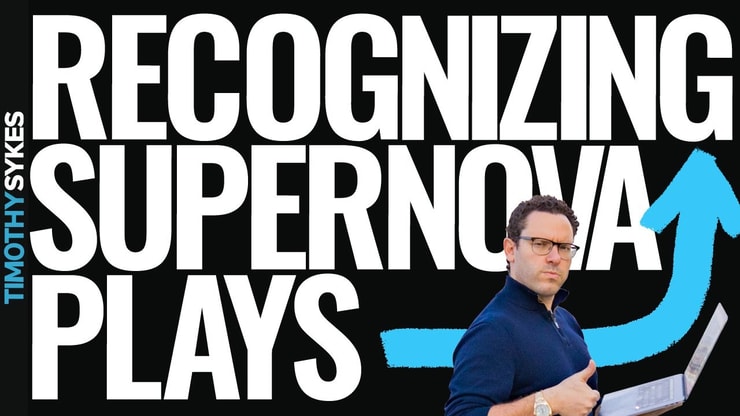What are the best ways to learn stock market basics?
That depends. Everyone learns differently. In this post, I’ll go over some of the options, so you can find which ones might work for you…
The stock market went through a lot last year. We saw one of the biggest crashes, followed by the strongest 100 days in history. It reminds me of the dot-com bubble of 2000, back when I was starting to trade.
I think there’s no better time than right now to learn stock market basics. There’s so much to watch and learn from.
As I always say, you have two accounts: your knowledge account and your broker account. Focus on your knowledge account first. This is a good place to start. And know that as top traders learn stock market knowledge, they learn to focus on the process.
Let’s get to it.
Table of Contents
- 1 What Is the Stock Market?
- 2 What Is Stock Trading?
- 3 Can You Learn to Trade by Yourself?
- 4 Importance of a Mentor to Learn About the Stock Market
- 5 7 Top Ways to Learn About the Stock Market
- 6 3 Top Stock Market Courses for Beginners
- 7 What Are the Top Sources to Learn About the Stock Market?
- 8 Bonus Tip: How to Trade Stocks as a Beginner With Little Money
- 9 Conclusion: How to Learn About the Stock Market
What Is the Stock Market?

There’s more to the stock market than investing in 401(k)s and mutual funds. Here’s a quick primer…
The stock market is a collection of exchanges where shares of publicly held companies are regularly bought and sold. Leading exchanges include the New York Stock Exchange (NYSE), the Nasdaq, and the American Stock Exchange (AMEX).
Stocks not on major exchanges can trade on the over-the-counter (OTC) markets.
Why is it important to learn stock market information? Because becoming a successful trader depends on your knowledge and ability to adapt to the stock market.
What Is Stock Trading?

Stock trading is the buying and selling of equity securities, aka shares. Traders buy and sell shares with the hopes of potentially profiting from price fluctuations.
For example, if a trader buys 10 shares of a company for $10 a share, their position would be worth $100. If the stock went up to $15 a share, that position would then be worth $150. However, if the stock dropped to $5 a share, it would be worth just $50.
Stock trading brings much-needed liquidity to the stock market. In a liquid market, there’s enough volume for traders and investors to easily enter and exit trades. Liquidity and volume are two things every trader should focus on to improve their skills.
Notice I said skills. Stock trading isn’t gambling. It’s a technique that can be mastered. Still, most traders lose. So to learn stock market trading and potentially profit from it, you have to work your butt off.
Can You Learn to Trade by Yourself?

Learning to trade isn’t easy. And trying to do it all alone is even harder. It’s not impossible, though…
If you want to learn to trade by yourself, you need to be honest. You have to admit you’re not perfect. You’ll need to learn the patterns, build a solid watchlist, time your trades, and adapt to the market.
That’s not easy, right? I know it can be hard, so I want to share my experience and speed up your learning curve. That’s why I became a teacher. And it’s why I have so many resources to help you learn stock market trading strategies, patterns, and more.
Start here with my free online guide.
Importance of a Mentor to Learn About the Stock Market
It’s important to have a good mentor to help you learn…
I became a teacher so I can share what I’ve learned in my 20+ years of stock market trading. I can’t make the learning process easy, but I can help speed it up.
That’s why choosing a mentor is so important. I’m not saying I’m the only option out there. Just make sure whoever you choose is transparent and shows every trade. Too many ‘gurus’ say they win 100% of the time. They’re lying. Get as far away from them as possible. Nothing good comes from lying about your trades.
A mentor can also help you discover some of the best ways to learn stock market material…
7 Top Ways to Learn About the Stock Market
There are so many ways to learn about the stock market. I can’t go over them all in this post, but I’ll give you my top seven…
1. Read Books
Books can be a great source of information. When you’re learning about the stock market or anything else, reading books can help you grow your knowledge account.
And they’re fairly cheap compared to classes or seminars.
Some will argue that books can be outdated. But in the stock market, I think it’s smart to study the past. Studying the past can help you prepare for the future. That’s why I consider myself a glorified history teacher. I use past market conditions to understand how the market can move.
My student Jamil put all my lessons into “The Complete Penny Stock Course.” It’s a great way to learn my stock market approach. (Learn more about it in a bit.)
And you can learn about my trading journey in my autobiography “An American Hedge Fund.” Grab your no-cost copy now to discover some of the hardest lessons I’ve had to learn (and how you can avoid making the same mistakes).
2. Read Articles
News articles can be another great way to learn stock market material. An article can give you a lot of valuable information in a short document. You can learn a lot without taking weeks to go over a single concept.
The downside is that articles typically don’t contain all the nitty-gritty details. That’s good in some cases, but bad in others. If you read an article and feel like there are missing pieces, find other sources that can help fill in the blanks.
You can find plenty of articles and posts to help you learn the stock market and trading here.
More Breaking News
- Why is Intuitive Machines Bouncing Back? Let’s Dive In!
- Zeekr’s Unexpected Surge: What’s Fueling the Rapid Rise?
- KULR Technology Group’s Bold Move: Investing Big in Bitcoin
3. Study and Analyze Successful Traders
This goes hand in hand with having a good mentor.
Study successful traders. I don’t think everyone should copy my trading style just because I’ve made over $6 million in trading profits.* Instead, analyze my trading style and find bits and pieces that can help you improve your style.
Analyze what successful traders do. Take the good from every trader and apply it to your own style. That can help you learn stock market information on your road to becoming self-sufficient.
(*Please note: My results are far from typical. Individual results will vary. Most traders lose money. I have the benefit of years of hard work, dedication, and experience. Trading is inherently risky. Do your due diligence and never risk more than you can afford to lose.)
4. Keep a Trading Journal
A trading journal is essential on your journey to understanding the stock market.
The stock market changes constantly — every day, month, and year. A trading journal can help you keep up and compare the current market to past markets. This is the ultimate tool in understanding and adapting to the market.
Trading journals aren’t only useful for learning about the stock market — they’ll also help you see what trading strategies work for you.
Let’s say you make 100 trades and you profit 50% of the time. Now, go back and look at every single trade to see what you did on your winning trades and what you did on your losses.
Maybe you’ll see that you were successful on supernova plays, but you failed on dip buys. In the future, you’ll focus more on supernovas and not as much on dip buys. That’s how to become a self-sufficient trader.
5. Focus on Your Education
The internet is the great equalizer. At least, that’s what I think. You can find so many online lessons and webinars that teach stock market trends and methods. Many don’t cost a dime. (Check out my YouTube channel for regular updates on the market and trading lessons.)
Be choosy, though: There are a lot of scams and fraudsters out there. Do thorough research to find what’s a good fit for you.
6. Follow Market Trends
Watching financial news for just a few minutes a day can give you a good understanding of overall market trends. And it can help you get familiar with stock market terminology.
Good resources for overall market trends include CNBC, MarketWatch, Wall Street Journal, Bloomberg, and Yahoo! Finance. Spending a little time on one, two, or even all of these sites can help you spot overall market trends.
Why would overall market trends matter for a trader? Because even though momentum stocks don’t follow the overall market in lockstep, they do tend to do better when the market’s on the way up.
7. Practice What You Learn
The last and arguably the most important step in learning about the stock market is to practice what you learn. There’s no better way to understand the market than to test it out yourself.
You’ve heard it before: practice makes perfect. No trader will ever be perfect in the sense that they’re right on 100% of their trades. So forget perfection. Focus on getting in the right trading mindset and mastering your emotions.
Some of my top students say emotions are harder to master than trading patterns. I agree. I’ve seen lots of newbies come into trading with the money mindset and end up getting crushed. You can’t expect the market to adapt to your trading. You have to adapt to the market and take it one trade at a time.
Trading’s a marathon, not a sprint!
3 Top Stock Market Courses for Beginners
It’s important to carefully pick what courses you pick to learn stock market material. Let’s go over three of the top stock market courses for beginners…
The Complete Penny Stock Course
“The Complete Penny Stock Course” is a great resource for new and veteran traders. My student Jamil put it together. It’s an organized compilation of my lessons. I think this should be required reading for all penny stock traders.
It can teach you how to manage risk, develop a trading plan, check your emotions, and recognize patterns.
There isn’t another book I’ve seen that has so many lessons all in one place. Grab your copy today and start prepping for the penny stock market now!
30-Day Bootcamp
The 30-Day Bootcamp is an amazing course I put together with the help of one of my top students, Matthew Monaco. We launched this course in mid-2020, and it’s had a great reception.
The 30-Day Bootcamp is designed to give you 30 lessons in 30 days, but you can go at your own pace and repeat lessons at any time. You get lifetime access. Bonus: It comes with a copy of “The Complete Penny Stock Course” and my “Pennystocking Framework” DVD.
Bootcamp lessons are broken up into three phases. The first phase goes over the fundamentals, the second covers strategies and patterns, and in the third, you’ll get live practice.
This is such a great resource for beginners. Get in while it’s still a steal at just $79.
Trading Challenge
My Trading Challenge is my top-level training to learn stock market trading.
The Challenge gives you access to over 6,000 video lessons, all my DVDs, live webinars, and a killer chat room where top traders and I mentor others. It’s an opportunity to learn stock market information that can change your trading for good.
I’ve had multiple students join the Challenge with just a few thousand dollars in their trading account and turn it into six, seven, and even eight figures.* Sounds great, right? The problem is, most people won’t work nearly as hard as they did.
(*Please note that these kinds of trading results are not typical. Most traders lose money. It takes years of dedication, hard work, and discipline to learn how to trade. Individual results will vary. Trading is inherently risky. Before making any trades, remember to do your due diligence and never risk more than you can afford to lose.)
Not everyone is accepted into the Challenge. You have to apply and go through an interview process with my team. I want to know why you want to be part of the Challenge. If it’s only to get hot picks, don’t bother. I want dedicated students who are in this for the long haul.
Click here to apply and prove you’re up for the Challenge.
What Are the Top Sources to Learn About the Stock Market?
I’ve just given you some of the top sources to learn stock market basics…
Books and online courses can give you good information about how the stock market works and the best ways to approach trading.
If you join me, I’ll share my years of experience and knowledge with you to help you improve your trading. But ultimately, it’s up to you to work toward becoming a self-sufficient trader.
Remember, trading isn’t easy. You won’t become an instant millionaire. You gotta work hard and stick with it.
Bonus Tip: How to Trade Stocks as a Beginner With Little Money
Most students come to me with small accounts. That’s OK! It might be a little harder and require more discipline, but to me, trading with a small account is the same as trading with a large account.
In fact, I prefer students start with small accounts so they can learn the process before scaling up.
With a small account, you have to learn to cut losses quickly and never risk more than you’re willing to lose on any single trade. Otherwise, you risk blowing up your account. Game over.
You will lose in the beginning. It’s more important to stay in the game and learn the right process than to make money and learn the wrong process. Keep that in mind as you start trading.
Conclusion: How to Learn About the Stock Market

There are lots of ways to learn stock market material.
Everyone has their own way of learning, and you need to find what works best for you.
I created the Trading Challenge so I can share what I’ve learned in my 20+ years of trading. If you’re just getting started, check out the resources I shared in this post to kick off your education.
Apply to join my Challenge if you’re ready for more — and willing to push yourself harder than ever to understand how this niche works.
No matter what tools you use to learn stock market trading, it’s up to you how hard you push yourself. I’ve seen traders blow up their accounts and blame everyone and everything but themselves. But at the end of the day, it’s all up to you.
What are you using to learn about the stock market? Let me know in the comments…






Leave a reply